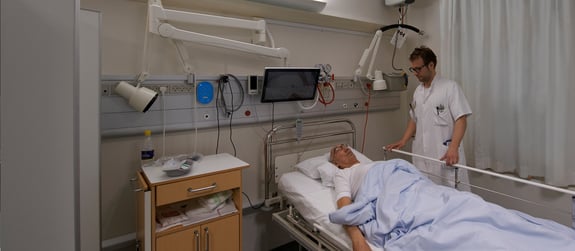Circadian lighting has a significant impact on stroke patients admitted for rehabilitation for more than 2 weeks.
Around one in three patients experience depression, severe fatigue, and circadian rhythm disturbances following a brain haemorrhage (stroke). These complications lead to reduced daily activity levels and increased mortality rates.
— Maintaining a natural circadian rhythm can be a significant challenge for patients admitted to hospitals. Patients undergoing rehabilitation after a stroke or brain haemorrhage are often immobile and lack exposure to the necessary light for establishing a stable sleep-wake cycle, explains Dr Anders West, a physician at Rigshospitalet Glostrup.
A Danish research project at the Stroke Unit, Neurology Clinic, has been investigating the significance of circadian lighting for stroke patients admitted for rehabilitation since 2013.
The study demonstrates that circadian lighting effectively combats and treats depression that arises from blood clots or bleeding in the brain. Moving forward, circadian lighting should be considered an integral part of the treatment environment during a two-week rehabilitation program.
—Anders West, Doctor, Ph.D.
In collaboration with lighting experts from Chromaviso, the research group and operations department at Rigshospitalet Glostrup have developed circadian lighting. This innovative lighting system is specifically designed to maintain the natural sleep-wake cycle by mimicking the natural light of the sun throughout the day, creating the necessary balance of light and darkness.
Methodology
Dr Anders West, in his PhD project, has explored the impact of natural circadian lighting on the health of patients in the Stroke Unit's rehabilitation ward. This groundbreaking international study is the first of its kind to measure the effects of circadian lighting on hospitalized patients.
The study is a randomized clinical controlled trial involving a total of 90 patients, with half of them receiving treatment in a ward equipped with circadian lighting, while the other half, the control group, stayed in a ward with standard lighting. Various methods, such as the Hamilton Rating Scale for Depression, The Major Depression Inventory scale, Epworth Sleepiness Scale, the Multidimensional Fatigue Inventory questionnaire, Rested Statement and Visual Analog Scala for fatigue, were utilized for data collection.
Findings
The study demonstrated significant clinical effects with the following results:
- Reduced depression – significance.
- Reduced fatigue - significance.
- Reduced anxiety - significance.
- Improved circadian rhythm according to the markers cortisol and melatonin - significance.
- Improved well-being - significance.
The results have been published in Anders West's PhD thesis, presented at international conferences, and peer-reviewed and published in scientific journals such as the International Journal of Medical Science (2019) and Chronobiology International (2017).

Until now, research has been unable to explain the fatigue experienced by stroke patients. The fatigue is believed to be a result of the brain injury, and not solely due to the poor sleep that most patients experience. This study on circadian lighting is the first non-pharmacological randomized study with a control group that demonstrates the effect of non-medical stimulation on fatigue in stroke patients.
— In collaboration with Chromaviso, we have developed a customized lighting protocol that caters specifically to the needs of the patients. This protocol determines the precise combination of colour temperature, intensity, timing, and duration of light throughout the day, he explains.
Publications:
- European Stroke Conference, Prag 2017
- PhD thesis: The Effects of Naturalistic Lighting on stroke patients, Copenhagen University 2018
- Impact of Naturalistic Light on Hospitalized Stroke Patients in a Rehabilitation Unit – Design and Measurement
- The effects of Naturalistic light on melatonin and cortisol diurnal blood levels in Stroke patients during admission for Rehabilitation – a randomized controlled trial
- The effects of Naturalistic light on Fatigue and Subjective sleep quality in Stroke patients during admission for Rehabilitation – a randomized controlled trial
- The effects of Naturalistic light on Depression, Anxiety and Cognitive outcomes in Stroke patients during admission for Rehabilitation – a randomized controlled trial
International Stroke Conference, Houston, USA 2017

